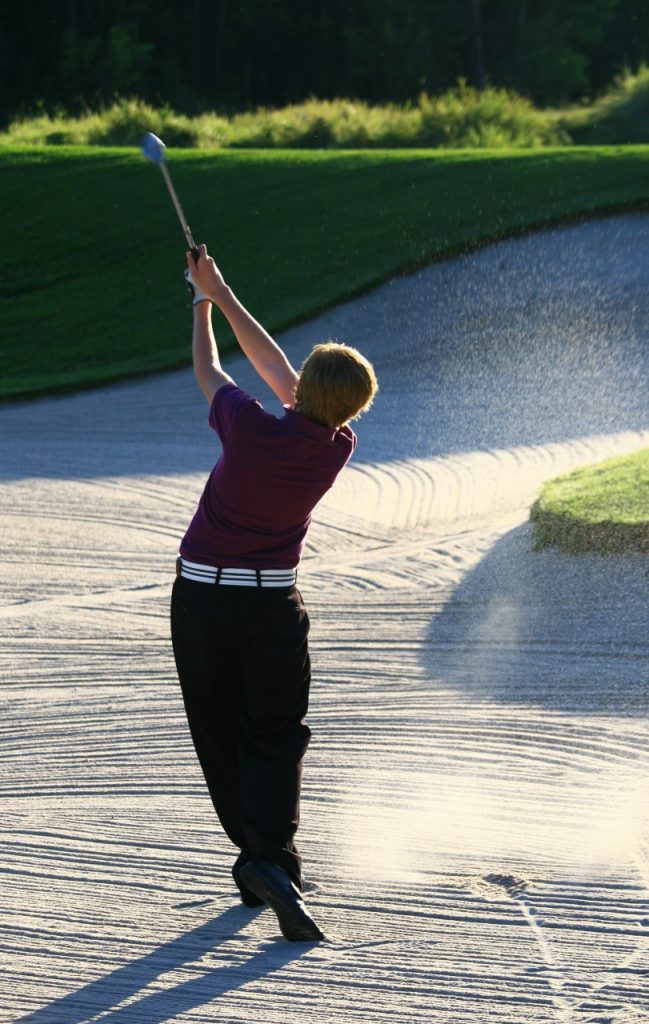
Protecting yourself During Golf Season: Common Golf Injuries
Golf injuries, believe it or not, are rather common, with injury rates ranging from 25% to 60% of players. Although we see relatively few traumatic injuries compared to other contact sports, the repetitive nature of the golf swing places us at risk for many overuse injuries. Individuals over the age of 50 and those with a lower handicap (1 to 9) tend to have higher injury rates. In amateur golfers the three most common sites of injury include the lower spine, the elbow and the wrist/hand. Knee injuries can also be problematic for golfers.
LOWER SPINE
The spine sees tremendous force during the golf swing. It has been shown that amateur players create higher forces in the spine than professional players due to aggressive swings with multiple technical flaws. These forces can lead to a variety of spine injuries: paraspinal muscle strains, ligament sprains, bulging or herniated discs and facet joint inflammation. Particularly in older golfers, underlying arthritis can make them much more susceptible to spine injury. Fortunately, most of these spine injuries can be treated without surgery. Rest, anti-inflammatory medications and physical therapy usually are the first-line of treatment. Occasionally, if other treatment options are unsuccessful, a corticosteroid injection (cortisone) may be needed to alleviate the pain and inflammation from these injuries.
ELBOW
Medial epicondylitis, commonly known as “golfer’s elbow”, and lateral epicondylitis, or “tennis elbow”, are the most common elbow problems and they occur in equal frequency among golfers and cause pain on the outside or inside of the elbow, respectively. Although their names imply “inflammation”, it is actually a degeneration or partial tearing of the tendons that attach to the elbow and control the function of the wrist and hand. Therefore, unfortunately, over-the-counter anti-inflammatories such as ibuprofen may not be helpful for these conditions. Elbow and wrist bracing are a common strategy designed to decrease strain on the tendons. No single brace has demonstrated consistent superiority in treatment. Rest from the offending activity, ice and physical therapy may be helpful. Many patients may require an injection of corticosteroids or platelet-rich plasma (PRP) to alleviate the pain. Rarely do these conditions lead to surgery.
WRIST and HAND
The repetitive wrist motion involved in the golf swing can result in many overuse injuries. These typically manifest as tendinitis and can occur in a variety of tendons. One of the more common is de Quervain’s tenosynovitis, which results in pain along the thumb side of the wrist. In general, tendonitis typically responds to a period of rest, ice, anti-inflammatory medication and immobilization. If not, a corticosteroid injection can help alleviate the symptoms. Even with proper mechanics the wrist is vulnerable as this is the most common site of injury among professional golfers. Occasionally, chronic stress fractures can develop in the wrist and even acute fractures can occur due to striking unseen roots, rocks, etc. in the ground.
KNEE
Acute knee injuries are unusual in golf but the golf swing more commonly can exacerbate or worsen underlying knee problems due to the repetitive loading and pivoting on the front knee. The most notable of these is an underlying meniscus tear. Meniscal tears usually cause focal pain along either the inside or outside aspect of the knee. Due to poor blood supply they often will not heal and eventually many of these tears will require surgical intervention in an active individual. Arthroscopic meniscus surgery is by far the most common surgery performed in orthopedics today. However, as we have discussed above, hopefully with various medications, injections and other rehabilitative treatments will minimize the pain and keep you making birdies through the golf season…until your knee really becomes at risk when ski season arrives!
PREVENTION
There is debate as to whether warming up or stretching can decrease the risk of injury in golf. As in other sports, strength and conditioning programs have been shown repeatedly to not only improve performance but to decrease injury rates as well. In addition, technique and improved swing mechanics can also decrease injury rates, particularly in the spine. If you are experiencing injuries in these or other places throughout your season, make sure you are talking with your athletic trainers and coaches to ensure you are receiving the proper training and treatments. If they feel it is necessary they may send you to see a sports medicine specialist or physical therapist for further intervention.
Todd Wente, MD
Panorama Orthopedics & Spine Center
Sports Medicine Specialist
Dr. Wente is a sports medicine specialist from Panorama Orthopedics & Spine Center, he works out of the Castle Rock office and sees patients Monday, Wednesday and Friday in clinic. For more information on Dr. Wente visit: https://www.panoramaortho.com/find-a-doctor/dr-todd-wente/